Mineral fluorescence under blue light – norbergite and corundum (ruby)
Posted On: Saturday, March 21, 2015
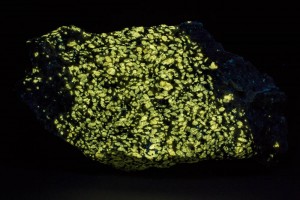
The geology community knows a lot about mineral fluorescence under excitation by various wavelengths of ultraviolet light but when it comes to excitation by light in the visible portion of the spectrum, such as blue, … not so much. In December 2013 Charles Mazel (NIGHTSEA) and Earl Verbeek (Sterling Hill Mining Museum) explored the extensive collection of the Franklin Mineral Museum (Franklin, New Jersey, USA) for instances of blue-light-stimulated fluorescence. When fluorescence occurred the specimen was photographed under white light, fluorescing under blue light, and fluorescing under either or both of shortwave and longwave ultraviolet light. The results were published in September 2014 – Mazel, C.H. and Verbeek, E.R. (2014), Fluorescence of minerals under blue light. The Picking Table (Journal of the Franklin-Ogdensburg Mineralogical Society), vol. 55, no. 2, p. 13-25.
We will share the photographic results in a series of blog posts, each documenting one specimen. See the summary of all posts to date.
The editors of The Picking Table have graciously allowed us to make the fall 2014 issue with our article on blue light mineral fluorescence available for free download. Click the image of the cover to access the pdf. And we certainly encourage you to join FOMS so that you can keep up with their activities and receive future issues.
Mineral (primary) – Norbergite and corundum (ruby)
Specimen identifier – Boyer 1262
Approximate size (cm) – [not measured]
Appearance –
White light – tawny yellow grains are norbergite; white to gray is calcite; silvery reflective nonfluorescent grains are pyrrhotite; corundum too small to discern
Blue light – fluorescence: yellow grains are norbergite; tiny red grains are corundum (ruby)
Shortwave ultraviolet – fluorescence: bright pale yellow is norbergite; ruby corundum nonfluorescent under this wavelength
Longwave ultraviolet – fluorescence: pale bluish-white is norbergite; dim red is corundum (ruby); weak reddish violet (principally at right) is light leaked through filter and reflected from calcite
(Click on image for larger view)
- White light
- Blue light
- Norbergite and corundum fluorescence, blue light
- Shortwave ultraviolet light
- Longwave ultraviolet light


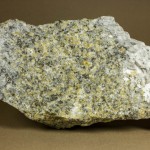
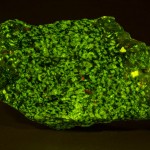
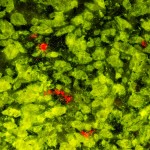
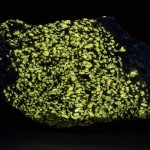
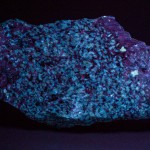
Looks like norbergite from Franklin Marble possibly Franklin Quarry or Limecrest Quarry, Sparta, NJ
I strongly doubt there is corundum present the weak red is probably zones of weak red fluorescent calcite which is commonly found in the marble quarries of the Franklin Marble
According to Earl Verbeek of the Franklin Mineral Museum – “It’s corundum. I haven’t reinspected the Boyer specimen but just looked at one of my own. The grains are pink to pinkish-violet in daylight, and I’ve never seen calcite of that color in the Franklin quarry. The rest of the calcite in the specimen – and there is a lot of it – is white and doesn’t fluoresce. Some of the pink corundum grains are embedded IN the calcite, and the corundum fluoresces and the calcite does not. The corundum fluoresces LW but not MW or SW, the opposite of most local calcite. I attempted to scratch a couple of grains with a knife. Under a hand lens I see small “smears” of metal on the pink grains, indicating the knife blade had been abraded by the grain. Also, corundum is a known constituent of the Franklin Marble and has been found, albeit sparingly, over a wide area for many decades.”